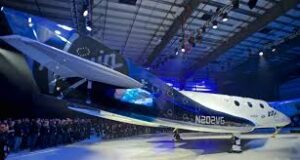
The concept of commercial space travel is, in many ways, still science fiction. It is expensive and dangerous and requires technology that’s still being developed. However, a few names do pop up when discussing the topic. One is Elon Musk’s company SpaceX, but there is competition- Virgin Galactic.
Virgin Galactic, the space travel division of the Virgin Group, has been gaining plenty of buzz after a successful flight. The SpaceShipTwo VVS Unity completed her first manned flight on April 5th, one of the final tests the supersonic rocket-powered vehicle needed to complete. It is the first time a Virgin craft of any kind has flown since 2014, when the VSS Enterprise crashed and killed the co-pilot.
There are still plenty of tests to go, however. One successful flight does not mean complete safety and functionality. Virgin co-founder Richard Branson is optimistic though. In a tweet, he said that things are “back on track” and that “space feels tantalizingly close now.” In a way, it is; Virgin hopes to launch their commercial service by the end of the year (at $250,000 per seat).
.@virgingalactic back on track. Successful powered flight, Mach 1.6. Data review to come, then on to the next flight. Space feels tantalisingly close now.
— Richard Branson (@richardbranson) April 5, 2018
At the very least, those seats will be incredibly comfortable. The SpaceShipTwo’s cabin was built for optimal comfort and protection and features custom-built, articulated seats. The cabin- and the rest of the ship- also have the most windows on any spacecraft ever. Seeing as the ship is more-or-less meant for sightseeing, the inclusion is logical. It can hold up to eight people per flight safely, including the pilots.
On the scientific side of things, the SpaceShipTwo uses a hybrid rocket motor for power. The combination of solid and liquid rockets gives it simple controls and easy maneuverability, with the ability to stop without repercussion anytime during flight. The most notable feature is how the craft can change shape mid-flight. Before descent, the tail and wings shift to point upwards, creating a shape akin to that of a shuttlecock. This feathered design ensures a safe re-entry that can be repeated indefinitely. In fact, the entire spacecraft is reusable, save for the used fuel and oxidizer.
When the time comes for Virgin Galactic’s commercial service to take off (no pun intended), passengers shouldn’t expect to just immediately board and travel to the moon. According to the company’s website, the price tag includes three days of astronaut training and custom flight suits. This training includes “how to make the most of [their] time spent in microgravity” and “how to be safe and comfortable during periods of high acceleration.” The visit to space will last only a few minutes, long enough to give passengers a chance to experience weightlessness and admire the beauty of the sky.
Virgin Galactic’s other vehicle is WhiteKnightTwo, a jet designed to bring the SpaceShipTwo up to orbit. The craft has a dual fuselage and four engines, giving it enough power to bring SpaceShipTwo up to an altitude of about 50,000 feet. WhiteKnightTwo’s cabins are also built from the same mold as the main spacecraft, making it the perfect place for the aforementioned astronaut training to be hosted.

Virgin Galactic is slowly shaking the stain the 2014 crash left on them, and this newest success will do much to improve their reputation. But there is still much to be done before the company is completely trusted or, indeed, before the SpaceShipTwo is ready for her true maiden voyage. But the era of commercial space travel is on the horizon, and Virgin Galactic is headed straight into the sunrise. At least the time between now and blast off will give us time to save up the funds for the trip.







